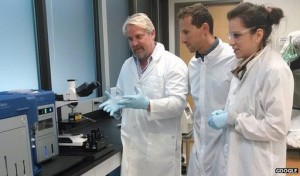 Google is developing cancer and heart attack detector
Google is developing cancer and heart attack detector
Google is aiming to diagnose cancers, impending heart attacks or strokes and other diseases, at a much earlier stage than is currently possible.
The company is working on technology that combines disease-detecting nanoparticles, which would enter a patient’s bloodstream via a swallowed pill, with a wrist-worn sensor.
The idea is to identify slight changes in the person’s biochemistry that could act as an early warning system.
The work is still at an early stage.
Early diagnosis is the key to treating disease. Many cancers, such as pancreatic, are detected only after they have become untreatable and fatal.
There are marked differences between cancerous and healthy tissues.
Google’s ambition is to constantly monitor the blood for the unique traces of cancer, allowing diagnosis long before any physical symptoms appear.
The project is being conducted by the search company’s research unit, Google X, which is dedicated to investigating potentially revolutionary innovations.
It marks the firm’s latest shift into the medical sector following its work on glucose-measuring contact lenses for patients with diabetes and the acquisition of a start-up that developed a spoon to counteract the tremors caused by Parkinson’s disease.
Google has also bought stakes in Calico, an anti-ageing research company, and 23andMe, which offers personal genetic-testing kits.
Nanoparticles
The diagnostic project is being led by Dr Andrew Conrad, a molecular biologist who previously developed a cheap HIV test that has become widely used.
“What we are trying to do is change medicine from reactive and transactional to proactive and preventative,” he told the BBC.
“Nanoparticles… give you the ability to explore the body at a molecular and cellular level.”
Google is designing a suite of nanoparticles which are intended to match markers for different conditions.
They could be tailored to stick to a cancerous cell or a fragment of cancerous DNA.
Or they could find evidence of fatty plaques about to break free from the lining of blood vessels. These can cause a heart attack or stroke if they stop the flow of blood.
Another set would constantly monitor chemicals in the blood.
High levels of potassium are linked to kidney disease. Google believes it will be possible to construct porous nanoparticles that alter colour as potassium passes through.
“Then [you can] recall those nanoparticles to a single location – because they are magnetic – and that location is the superficial vasculature of the wrist, [where] you can ask them what they saw,” said Dr Conrad.
Unattached nanoparticles would move differently in a magnetic field from those clumped around a cancer cell.
In theory, software could then provide a diagnosis by studying their movements.
As part of the project, the researchers have also explored ways of using magnetism to concentrate the nanoparticles temporarily in a single area.
The tech company’s ambition is ultimately to create a wristband that would take readings of the nanoparticles via light and radio waves one or more times a day.





